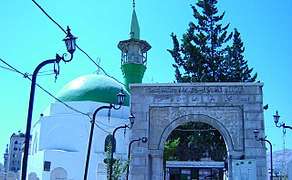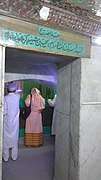Daughters of Husayn ibn Ali
The Islamic figure Husayn ibn Ali had three daughters: Ruqayyah (Arabic: رُقَيَّة),[lower-alpha 1] Fāṭimah aṣ-Ṣughrā (Arabic: فَاطِمَة ٱلصُّغْرَىٰ, "Fatimah the Younger")[2] and Fāṭimah al-Kubrā (Arabic: فَاطِمَة ٱلْكُبْرَىٰ, "Fatimah the Elder").[3][4][5][6]
| Part of a series on Islam Shia Islam |
|---|
 |
|
Beliefs and practices |
|
|
Holy women |
|
|
Ruqayyah
Shi'ite narrative
The story of Sakinah is one of the many emotional stories that Shī‘ī Muslims tell about Husayn and his martyrdom at the hands of Yazid's troops. The Battle of Karbala and the subsequent events at the court of Yazid are explained and mourned annually during the commemoration of the 10th of Muharram, also known as ‘Âshûrá’ (Arabic: عَـاشُـورَاء, tenth day). According to these religious narrations, Sakinah suffered from fatigue and thirst on the forced march to Damascus, and later from cold and starvation in Yazid's dungeon.[7]
Journey to Iraq and Shaam
She accompanied her father when he traveled from Mecca to Kufah in Iraq. On the 2nd of Muharram, 61 AH (680 CE), Husain and 72 of his family members and companions were forced to camp in the plains of Karbala by Yazid's army of 30,000 men. Yazid ibn Muawiyyah was the practical Caliph who desired religious authority by obtaining the allegiance of Husain, but the Imam would not give up his principles. On the 10th of Muharram, the Imam's household was attacked, a number of his companions were killed, and the survivors were made captives. The survivors included the Imam's sisters, wives, and daughters, including Sakinah, relatives of companions of the Imam, and his son, Ali Zaynul-Abidin, who did not participate in the battle, due to an illness. Sakinah, as with others, had been grieved over the killings. They had also suffered from thirst.[8]
The survivors were marched by Yazid's army from Karbala to Kufah, where Sakinah received water from a sympathetic woman, and then to Damascus in Shaam. There was a lack of pity from the captors' part during the journey. Even at these times of hardship and misery, Ruqayyah was sympathetic to others, such as her mother, whom she consoled her mother on the death of Ali al-Asghar.[8][9][10]
Death and aftermath
According to Shia Islamic narrations that are commemorated every year on the occasion of Ashura, after enduring the Battle of Karbala and the torturous journey to Damascus that followed it, Sukaynah died at the age of four weeping over her father's head in Yazid palace hall where prisoner were initially stayed and, her body was originally buried at nearby site. Centuries later, an ʿĀlim (Arabic: عَالِم, Scholar) had a dream in which Sakinah asked him to move her body from the grave to another site, due to water pouring into her grave. He and some people opened the grave, and saw that ground water was indeed entering the grave, besides that her body was still intact. Sakinah's body was moved from its original burial place, the dungeon, and reburied where her Mosque is now located.[11][12]
The mosque was built around the mausoleum in 1985 and exhibits a modern version of Iranian architecture, with substantial amount of mirror and gold work. There is a small mosque area adjoining the shrine room, along with a small courtyard in front. This mosque is found a short distance from the Umayyad Mosque and the Al-Hamidiyah Souq in central Damascus.
 Sayyidah Ruqayya Mosque, which contains the qabr (Arabic: قَبْر, grave) of Ruqayyah, in Damascus, Syria
Sayyidah Ruqayya Mosque, which contains the qabr (Arabic: قَبْر, grave) of Ruqayyah, in Damascus, Syria Ruqayyah's zarih with a chandelier over it
Ruqayyah's zarih with a chandelier over it.jpg) An Iranian child in Mourning of Muharram, with a red Headband written "O Ruqayyah"
An Iranian child in Mourning of Muharram, with a red Headband written "O Ruqayyah" Name board on the mosque
Name board on the mosque Hall of Yazid Mahal where Ruqayya died weeping over her father's head
Hall of Yazid Mahal where Ruqayya died weeping over her father's head
Family tree
| Adam | |||
| Nuh (Noah) | |||
| Ibrahim (Abraham) | |||
| Isma'il Ishmael | Is-haq (Isaac) | ||
| 'Adnan (b.122 BC)
. . . . . . |
Ya'qub (Jacob) | ||
| 'Abd al-Mutallib | 'Isa (Jesus) | Musa (Moses) | |
| 'Abdullah (d.570 AD) | Abu Talib (d.620 AD) | ||
| Muhammad (d.632 AD) | |||
| Fatimah (d.11 AH) | ʿAli (d.661 AD) | ||
| Al-Husain (d.680 AD) | |||
| Sakinah / Ruqayyah (d.680 AD)[13] | |||
Fatimah as-Sughra
It is believed that there were two daughters of Husayn who had the name 'Fatimah': Fatimah al-Kubra ("Fatimah the Elder") and was 11 years old during the Battle of Karbala, and Fatimah as-Sughra.[3][4][5][6]
As-Sughra was a daughter of Umm Ishaq bint Talhah.[2] It is believed that she was ill and left behind at Medinah, when her father took part in the Battle of Karbala (680 ACE).[14][15] Eventually, she accompanied her aunt Zainab to Shaam. She is believed to have died there, with her grave being in Damascus.[12]
 Grave of Fatema Sugra at Bab al-Saghir, Damascus
Grave of Fatema Sugra at Bab al-Saghir, Damascus Name on the grave
Name on the grave
Fatimah al-Kubra
According to the Shia, Husayn married Fatimah al-Kubra (Sakinah bint Hussain)[16] (born 669 ACE) to his brother Hasan's son Abdullah at Karbala.[4] Fatimah died in the year 736 ACE. Their Children Include: -Al Hasan Bin Hasan as. -Abdullah Bin Hasan as Alias Abdullah Al Mahez(Pure). The Progeny of Abdullah Al Mahez are in Multitude of numbers which Include: Sharif Of Mecca, Idris of Morocco, Ghaus e Azam Sheikh As Sayyid Abdul Qadir Al Jillani Al Hasni wal Hussaini. -Idrees Bin Hasan as. As such, she appears not only to have been a contemporary of her father and brother Ali Zaynal-Abidin, but also the later Shi'ite Imams Muhammad al-Baqir and Ja'far al-Sadiq.[3][4][5][6]
 Mausoleum Bab al-Saghir, which contains the grave of Fatimah al-Kubra in Damascus, Shaam
Mausoleum Bab al-Saghir, which contains the grave of Fatimah al-Kubra in Damascus, Shaam- The grave of Fatimah al-Kubra in the Levant
- Gold plated cage made on ground flour over the grave
- A wooden cage made around the grave
 name plate, zarih
name plate, zarih
See also
- Adnanites
- Arabs
- Banu Hashim
- Family tree of Husayn ibn Ali
- Fatimah bint Muhammad
- Fatimah bint Musa
- Quraysh
- Sayyidah Ruqayyah of Cairo
- Semite
- Umm ʿAmmar Sumayyah bint Khayyat, wife of Yasir ibn ʿAmir ibn Malik al-ʿAnsi
- Yahya ibn Zakariyya
Notes
References
- Arne, Ambros; Stephan, Procházka (2004). A Concise Dictionary of Koranic Arabic. Wiesbaden: Ludwig Reichert Verlag. p. 136. ISBN 3-89500-400-6.
- Islamic shi'ite encyclopaedia, Ḥasan Amīn, s.n., 1973 - Religion; "... Fatima; i^u her mother was Umm Ishaq bint Talhah ibn 'Abdullah."
- "The Role of Women in Karbala". Alimoula110.com. Retrieved 2015-07-02.
- Ihic.org Archived October 16, 2009, at the Wayback Machine
- Shia.org Archived March 1, 2009, at the Wayback Machine
- "(A.S.) Network". Imamreza.net. Retrieved 2015-07-02.
- Coej.org Archived February 14, 2011, at the Wayback Machine
- "The Fourth Journey – Kufa to Shaam | The Journey of Tears | Books on Islam and Muslims". Al-Islam.org. 2013-10-28. Retrieved 2015-06-02.
- Nafs ul Mahmoom by Sheikh ‘Abbas Qummi, Behar ul Anwaar, Vol I by ‘Allamah Sayyad Mohammad Baqir Majlisi and others.
- 'Summary of the Tragedy of Sayyeda Ruqayya', Booklet at Ruqayya Mosque, 2008
- "Syria". Mailviruskid.tripod.com. Retrieved 2016-10-14.
- "ʿALĪ B. ḤOSAYN B. ʿALĪ B. ABĪ ṬĀLEB". ENCYCLOPÆDIA IRANICA. Retrieved 1 August 2011.
- The Light, Volumes 12–13; Bilal Muslim Mission of Tanzania, 1978 – Islam; " ... said that Imam Husain (a.s.) had another daughter named Fatema, we have to point out that she was Fatema Sughra ..."
- The Immortal Poetry & Mir Anis: With the Versified Translation of a Marsia of Mir Anis; Syed Ghulam Abbas, Mir Babbar Ali Anis, Majlis-e-Milli, Pakistan, 1983 – Elegiac poetry – 368 pages; "Umme Salma loved Husain very much. At the time of Huasin's departure from Madina, she was left there due to her old age and also to look after Fatima Sughra, the ailing daughter of Husain. Na'ni, Umme Salma. 6. AU, Son of Abu Talib ..."
- "The Story Of Sukaina Bint Al-Hussein A Muslim Heroine". Mathaba.net. 2007-05-07. Archived from the original on 2015-07-14. Retrieved 2015-07-02.
Bibliography
- Momen, Moojan An Introduction to Shi'a Islam, Yale University Press, 1985.